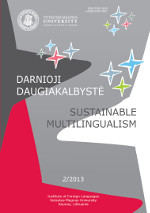Il lessico iniziale dell’italiano L2 nella classe lituanofona
Beginner’s Vocabulary of Italian as a Second Language in the Lithuanian Classroom
Author(s): Stefano Maria LanzaSubject(s): Foreign languages learning
Published by: Vytauto Didžiojo Universitetas
Keywords: Italian as a foreign language; vocabulary; frequency lists; contrastive analysis
Summary/Abstract: Teaching Italian as a foreign language vocabulary in the Lithuanian classroom is still an unexplored field of study. The article raises the question of the selection of the most important words for the beginners’ group. Rather than to present a simple list of words (or, more precisely, of lexical units), the focus is on the composition both of the general Italian vocabulary and of the one which has to be simplified for didactic reasons. Starting with the frequency list of Italian words LI P, the Lexicon of spoken Italian (developed in 1993), it is possible to create other lists of lexical units of any size. The article presents a 300 entries minimal dictionary, which is built however not by a mechanical transcription of the first 300 entry in the LI P: the list is revised on the basis of certain usage criteria (for example, by deleting entries which nowadays have already become out-of-date). Necessarily this process has a certain degree of subjectivity. Afterwards the list is analysed from a didactic perspective, assigning the lexical material to categories based on a predictable learning difficulty. Supposing that students know English, the following categories are defined: words which are common to Italian and Lithuanian, words which are common to Italian and English, Italian words which cannot be directly related to either language and the so-called “false friends”. The author expresses the view that the comparative-contrastive method better than others helps learners assimilate new vocabulary because they are lead to spend more time studying each lexical unit. Connections made by the students between elements of the foreign language and of the mother tongue (or another known language, such as English), their morphological features, their usage in a text, result in an overall improved effectiveness of the learning process.
Journal: Darnioji daugiakalbystė
- Issue Year: 2013
- Issue No: 2
- Page Range: 110-123
- Page Count: 14
- Language: Italian

